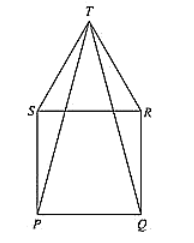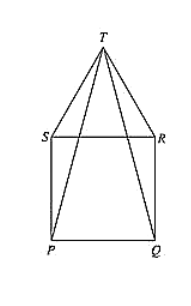In fig. (10).23, PQRS is a square and SRT is an equilateral triangle. Prove that (i) PT = QT (ii) ∠TQR = 15°
In fig. (10).23, PQRS is a square and SRT is an equilateral triangle. Prove that (i) PT = QT (ii) ∠TQR = 15°

Given that PQRS is a square and SRT is an equilateral triangle. And given to prove that
(i) PT = QT and (ii) ∠TQR = 15°
Now, PQRS is a square
PQ = QR = RS = SP ... (i)
And ∠SPQ = ∠PQR = ∠QRS = ∠RSP = 90° = right angle
And also, SRT is an equilateral triangle.
SR = RT = TS ... (ii)
And ∠TSR = ∠SRT = ∠RTS = 60°
From (i) and (ii)
PQ = QR = SP = SR = RT = TS .... (iii)
And also,
∠TSP = ∠TSR + ∠RSP = 60° + 90° + 150°
∠TRQ = ∠TRS + ∠SRQ = 60° + 90° + 150°
⟹ ∠TSR = ∠TRQ = 150° ... (iv)
SP = RQ [From (iii)]
So, by SAS congruence criterion we have
ΔTSP = ΔTRQ
PT = QT [Corresponding parts of congruent triangles are equal] Consider ΔTQR.
QR = TR [From (iii)]
ΔTQR is a isosceles triangle.
∠QTR = ∠TQR [angles opposite to equal sides]
Now,
Sum of angles in a triangle is equal to 180∘
⟹ ∠QTR + ∠TQR + ∠TRQ = 180°
⟹ 2∠ TQR + 150° = 180° [From (iv)]
⟹ 2∠TQR = 180° - 150°
⟹ 2∠ TQR = 30° ∠TQR = 15°] ...
Hence proved

Click here to get exam-ready with eSaral
For making your preparation journey smoother of JEE, NEET and Class 8 to 10, grab our app now.
